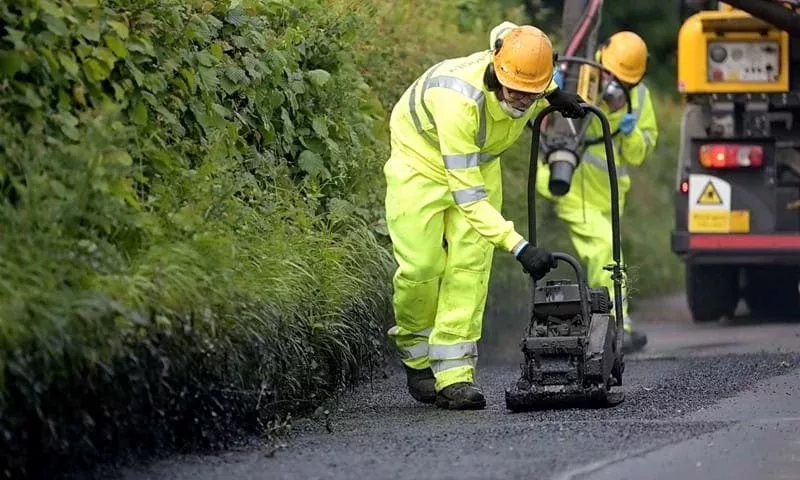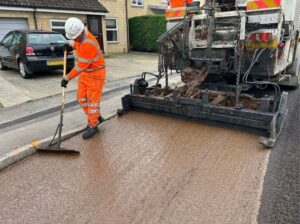A further package of multi-million-pound road repairs and improvements has started in West Sussex, proactively tackling the council’s current pothole issues and also investing in larger-scale resurfacing across the county’s 4,000km road network.
Following additional funds being added to last year’s budget for highways maintenance, West Sussex County Council is committed to tackling the impact of persistent, severe weather on the highway with both reactive and proactive measures, it said.
This financial year, in addition to the base budget for highways maintenance and operations of £43.8million, the council has invested:
- an extra £4million to support highway maintenance, including pothole repairs.
- an additional £7million to increase our carriageway resurfacing and treatments programme to more than £20million, enabling highways teams to deliver one of their largest programmes of works to date.
- a further £2million to tackle the significant carriageway patching backlog across the county following the very wet conditions over the last six months. This work will start in early summer to maximise the best working conditions.
The county council has so far received £4.3million (£2.161m in 2023/24 and £2.161m for 2024/25) from additional government funding announced in 2023. This funding will be used to deliver additional carriageway resurfacing works, with delivery having already started and the programme due to run to September 2024.
A further £10million from council funds has been committed for next year (2025/26) to continue the work needed to make the highway network more resilient for the future.
Cllr Joy Dennis, county council Cabinet Member for Highways and Transport, said: “As with many councils across the UK, we are faced with the challenge of our road network in West Sussex having gradually deteriorated over the years due to there not being enough funding available to carry out all the required works.
“Unfortunately, roads are not permanent structures and they deteriorate over time from constant use, the weight of vehicles using them and the effects of weather. The recent periods of extreme fluctuations in weather across the seasons, with record levels of rainfall this most recent winter, have only served to accelerate the decline in the condition of some of our highways.
“We totally understand residents’ concerns about the current number of potholes and other defects on our roads and share their frustration. These latest figures for highway repairs and improvements show that we’re not just talking about the challenge – we’re taking action. Our highways teams are continuing to work hard to fix the issues, completing multi-million-pound improvement programmes and demonstrating our commitment to our Better Roads campaign.
“We have teams of highway officers out on the network identifying and assessing safety-related defects including potholes, both through routine inspections and by responding to customer reports. Our safety repair gangs are then tasked with fixing the safety defects. During this busy period, we are currently fixing around 1,000 safety defects a week.”
Last year, the council’s safety repair teams completed more than 46,000 safety defect repairs, of which approximately 30,000 were potholes. This is an increase of more than 5,000 from the previous financial year.
In more rural areas, the council used three Velocity spray injection patchers to repair more than 23,000 further defects while also delivering proactive patching covering 26,000m2, which is equivalent to covering more than 130 tennis courts.
The West Sussex Planned Delivery team worked across 189km of roads in the last financial year, which were either completely resurfaced or had surface dressing, micro-asphalt treatments, or large-scale areas of patching and completed:
- 75 full resurfacing schemes were completed, totalling approximately 43km. The new road surfaces are more durable, making them more resilient to potholes, and smoother, which lessens road noise.
- Surface dressing was used at 31 sites, with 66km of roads treated. Surface dressing involves coating the road in bitumen and chippings and relies on the action of the traffic using the road to embed the chippings. It is used as a cost-effective method to prolong the lifespan of suitable roads.
- 277 sites received micro-asphalt treatment, covering a total of 69km. This treatment delays the need to do more significant work and minimises disruption to residents and road users.
- 11km of large-scale areas of patching were completed at 48 sites.
The council is responsible for maintaining around 4,000km of road: A and B roads are ordinarily inspected monthly, C-class and main distributor roads on a three or six-monthly basis and declassified roads are typically inspected annually.
PIC-WEST SUSSEX HIGHWAYS






















